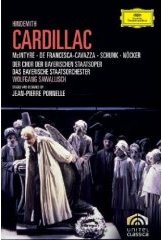

 |
 |
|
|
Hindemith – Cardillac  Cardillac – Donald McIntyre
His Daughter – Maria de Francesca-Cavazza
Officer – Robert Schunk
Lady – Doris Soffel
Cavalier – Josef Hopferwieser
Gold Merchant – Hans Gunter Nocker
Police Officer – Karl Helm
Bavarian State Orchestra and Chorus/ Wolfgang Sawallisch
Stage Director & Designer – Jean-Pierre Ponnell
Costume Design – Pet Halmen
Video Director – Brian Large
Recorded at Nationaltheater, Munich – September 1985
DGG 00440 073 4324 – 88 minutes
Paul Hindemith is one of those enfants terribles of the early twentieth century who became more conservative in later life. His operatic works have somehow fallen by the wayside of popularity as the years have progressed. He composed ten operas in all, with both the provocative subject matter and his complete mastery of theatre attracting interest and admiration.
For Cardillac he drew on the works of E T A Hoffmann’s parable about a 17th century master goldsmith. As readers of the latest Harry Potter book will know, the principle of the true owner of an object being its maker not its purchaser is still perfectly credible. The pivot in the drama is Cardillac’s conviction that “What I create is mine”, which drives him to murder his customers and regain possession of each jewel as it is sold. Ferdinand Lion’s libretto is well constructed. In the first scene we witness the growing panic of the crowd, as they round on innocents in their midst in their urgency to find and eliminate the murderer. Ownership of Cardillac’s jewels now carries a frisson of danger which becomes a fatal attraction for the cavalier and the lady. Their love scene, against a long orchestral interlude, is one of the most original and satisfying parts of the score, cruelly shattered by murder.
From this point on Cardillac is centre stage for the rest of the opera, with his mental stability crumbling beyond control. It’s a role that demands the highest vocal and dramatic abilities. Dietrich Fischer-Dieskau was a famous exponent and interpreter of the title role, and his 1968 radio broadcast with the Cologne Symphony Orchestra & chorus conducted by the great Joseph Keilberth was until recently the only issued recording. It remains available on CD (Opera d’Oro OPD 1427). Suddenly two recordings on DVD have been issued at virtually the same time, providing an opportunity to reassess this “lost” masterwork.
Here for the original 1927 version of Cardillac we have Pierre Ponnelle once again displaying his seemingly unerring ability to get a setting exactly right, with a 17th century Paris recreated in the idiom of the 1920’s.The flickering lighting and circular spotlights bring to mind early movies. Tip-tilted sets, model horses and carriages and delicate costumes, with lots of ivory and sepia, are evocative of Arthur Rackham’s book illustrations. Doris Soffel (the Lady) looks deliciously fragile in fur trimmed silk, and her Cavalier (Josef Hopferwieser) is chivalrous to a fault, and their balletic love scene is handled with great delicacy. Donald McIntyre’s Cardillac is a tour de force with just the right mix of cunning and madness for a man who values his creations to the point where he will commit murder for them. These jewels are represented as monsters focusing their radiance upon him from the rafters of his workroom. His indifference for his daughter is mirrored in a rather shadowy performance from Maria de Francesca-Cavazza, and officer (Robert Schunk) seems content to play along. The final scene takes place in one of those elegant Paris cemeteries – ivory statues and ivy – a very gothic and murderous place, preparing us for a climax which is both violent and poignantly distressing. Serena Fenwick BelAir Classiques (BAC023) have also released a contrasting production of this opera filmed at the Bastille Theatre, Paris in October 2005, which we hope to receive for review shortly [Editor].
|